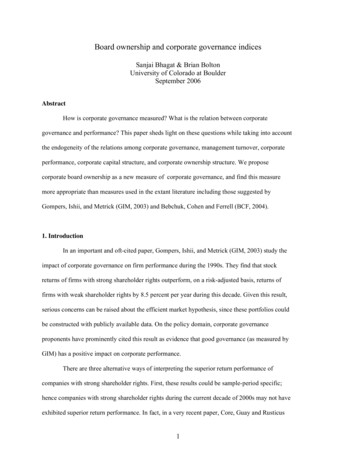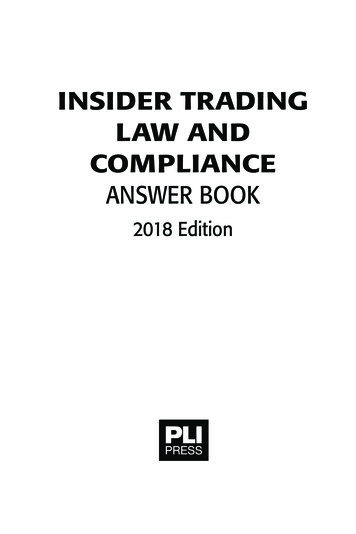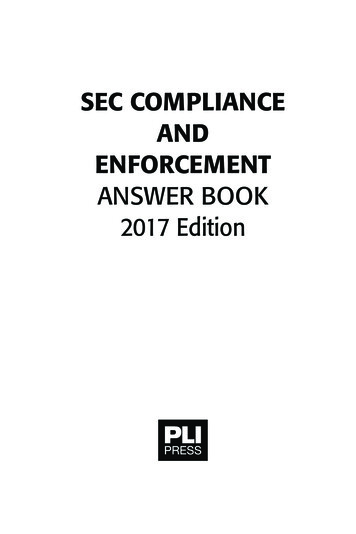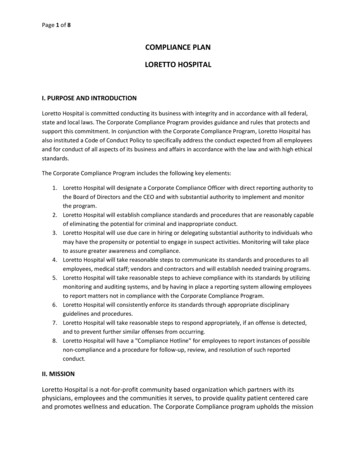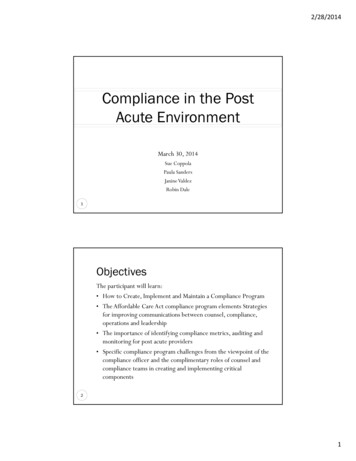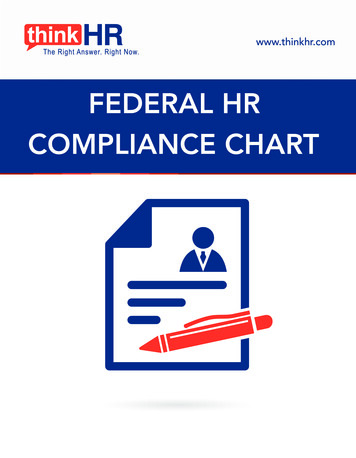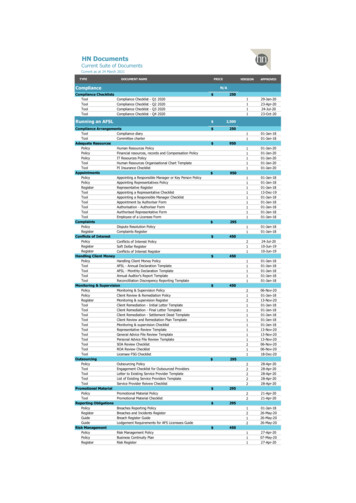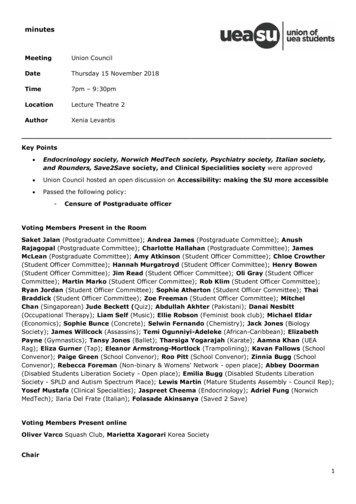
Transcription
Society of Corporate Compliance and EthicsFederal Contractor Compliance:What You Need to KnowMurray Simpson, Ph.D.Manager, Consulting Services9/13/11Federal Contractor Compliance 1Overview What regulations are enforced by the Office of FederalContract Compliance Programs (OFCCP)? What changes are taking place with regard to theseregulations? What items are increasingly subject to greater scrutiny bythe OFCCP during compliance evaluations? What can federal contractors do today to prepare for thechanges of tomorrow?Federal Contractor Compliance 21
What Regulations Are Enforced by the OFCCP? Executive Order 11246– Prohibits discrimination based on race, color, religion, sex or national origin– Requires contractors to engage in affirmative action for women and minorities– Requires contractors to maintain data on applicants, hires, promotions, transfers,and terminations by race and gender Section 503 of the Rehabilitation Act– Prohibits discrimination based on an individual’s physical or mental disability– If federal contract exceeds 10,000, requires contractor to employ and advance inemployment qualified individuals with disabilities– Requires contractors to take affirmative action to ensure individuals with disabilitiesare included in all employment activities and to make reasonable accommodationof the physical and mental limitations Section 4212 of Vietnam Era Veterans’ Readjustment Assistance Act– Prohibits discrimination based on covered veterans status– If federal contract prior to 12/01/2003 exceeds 25,000, (post 12/01/2003, 100,000) requires contractors to employ and advance in employment qualifiedcovered veterans– Requires contractors to take affirmative action to ensure covered veterans areincluded in all employment activitiesFederal Contractor Compliance 3Changing Regulatory Environment December 2010: OFCCP changes its enforcement protocol fromActive Case Management to Active Case Enforcement January 2011: OFCCP initiates process to rescind the standardsthat have governed since 2006 how the agency conducts acompensation audit April 2011: OFCCP proposes changes to the regulationsimplementing Section 4212 of VEVRAA May 2011: OFCCP proposes changes to the itemized listing ofdocuments and data that federal contractors must provide uponnotification of an audit August 2011: OFCCP requests input on developing a new tool tocollect compensation data from federal contractorsFederal Contractor Compliance 42
Increased Scrutiny by OFCCP During Compliance Audits Active outreach for veterans Active outreach for disabled individuals Reasonable accommodations for disabled individuals Web accessibilityFederal Contractor Compliance 5Changes in theOFCCP’s EnforcementProtocolFederal Contractor Compliance 63
OFCCP Has Changed Its Enforcement ProtocolActive Case Management (ACM)Active Case Enforcement (ACE) Compliance review only Compliance review, offsitereview of records, compliancecheck, or focused review Full desk audits only whenthere were indicators Full desk audits conducted inall compliance evaluations Focus: Systemicdiscrimination comprising atleast 10 class member bygender or race Focus: Individual as well asclass cases of discriminationwith no threshold on numberof class members by genderor raceFederal Contractor Compliance 7Rescission of StandardsGoverning How OFCCP Conductsa Compensation AuditFederal Contractor Compliance 84
Rescission of Standards Governing a Compensation Audit The OFCCP adopted a three-tiered audit strategy as themeans to implement these standards Tier 1 (“tipping test”) and Tier 2 (“mini-regression”)conducted as part of the desk audit Tier 3 (“comprehensive regression analysis”) conductedin association with an onsite reviewFederal Contractor Compliance 9Rescission of Standards Governing a Compensation Audit Tier 1 – Tipping Test– Item 11 data aggregated by “pay division” (usually job group or job title)– Under Active Case Management (2006-2010):» Thresholds 5/10/3 thresholds 5/10/3/30 thresholds» Typically between 40-60% of AAP establishments failed» Remainder passed and compensation review closed at desk audit stage– Under Active Case Enforcement (which requires completion of full deskaudit – meaning Tier 1 and Tier 2 until rescission process is completed)» Threshold: 2% or 2,000» Nearly 100% of AAP establishments fail» Automatically move forward to Tier 2 of the desk auditFederal Contractor Compliance 105
Rescission of Standards Governing a Compensation Audit Tier 2 – Mini Regression Analysis– OFCCP requests employee-specific data with which to conduct aregression analysis– Under Active Case Management (2006-2010):» OFCCP typically requested employee-specific data on 12 factors:1.2.3.4.5.6.7.8.9.10.11.12.Employee ID numberTime with company or date of hireTime in current position or date of last change in grade or titleDate of birth or, if possible, date of last degree earnedCurrent annualized base salary or base hourly wagePart-time v. full-time statusExempt v. non-exempt statusJob titleGrade level or salary bandLocation (if different from facility under review)GenderRaceFederal Contractor Compliance 11Rescission of Standards Governing a Compensation Audit Tier 2 – Mini Regression Analysis (continued)– Transition from Active Case Management to Active Case Enforcement» Additional factors began appearing in various combinations over thecourse of 2010:13.14.15.16.17.18.DivisionDepartmentWork shift, if applicableAAP job groupSimilarly situated employee groups (SSEGS), if developedOther paid allowances, if any, such as commission pay, overtime pay, bonus pay or shiftdifferential19. Any other factors not previously listed that impact compensation for your company– Under Active Case Management» Additional factors requested by OFCCP as recently as May-July, 2011:20. Last two performance ratings for each employee21. Education22. Prior experience outside the companyFederal Contractor Compliance 126
Rescission of Standards Governing a Compensation Audit Tier 2 - Blurring the Lines of Distinction with Tier 3– The expansion in the requested number of factors (i.e., data fields containingemployee-specific information) :» Indicates a movement by the OFCCP to push the Tier 2 analysis towardthe “comprehensive regression” stage previously reserved for the third tierof its audit strategy» As a consequence, the Tier 3 analysis associated with an onsite reviewlikely will focus on refining the Tier 2 analysis (with regard to any omittedinfluences on pay and to forming SSEGs) based on: OFCCP review of documented compensation policies OFCCP review of job descriptions OFCCP interviews of employees, supervisors, managers, and personnelin HR and compensation functionsFederal Contractor Compliance 13Changes to Compensation Data Requested in ItemizedListing That Accompanies 30-Day Scheduling Letter Employee-specific data as opposed to aggregated data– As of February 1st of the most recent year for all employees in the workforcecovered by the AAP (including full-time, part-time, temporary, contract, andper diem or day labor) provide the following:1.2.3.4.5.6.7.8.9.10.11.Employee ID numberGenderRace/EthnicityHire dateJob titleJob groupEEO-1 categoryBase salaryWage rateHours workedOther compensation or adjustments to salary (such as bonuses, incentives, commissions,merit increases, locality pay, and overtime)Federal Contractor Compliance 147
Changes to Compensation Data Requested in ItemizedListing That Accompanies 30-Day Scheduling Letter Employee-specific data as opposed to aggregated data– Federal contractor may provide data on additional factors used to determineemployee compensation, including but not limited to:12.13.14.15.16.17.EducationPast experienceDuty locationPerformance ratingsDepartment or functionSalary grade, band, level or range Contractor should also submit documentation and policiesrelated to its compensation practices, particularly those thatexplain the factors and reasoning used to determinecompensationFederal Contractor Compliance 15Where is the OFCCP Heading With Regard to Analyzing aFederal Contractor’s Compensation Practices? OFCCP will seek to collect a comprehensive set of payrelated data fields covering all employees in the AAP– In the short term, the OFCCP will use the nearly universal failure of the Tier 1Tipping Test (with differences in average pay of at least 2% or 2,000 for onejob title or job group resulting in failure) as the justification for requestingthese data fields– In the longer term, the OFCCP will abandon the Tier 1 Tipping Test becausethe revised Itemized Listing accompanying the 30-Day Scheduling Letterrequests these data fields as part of the supporting documentation and datathe federal contractor must provide in response to the letterFederal Contractor Compliance 168
Where is the OFCCP Heading With Regard to Analyzing aFederal Contractor’s Compensation Practices? Once the Tier 1 tipping test is abandoned, the OFCCP willconduct a single desk-audit analysis, which may be refinedduring an onsite review if such a review is warranted. During the desk audit, the OFCCP:–Will continue to analyze employee pay using a regression model–Will likely exercise greater latitude in how employees are grouped forcomparison–Will likely combine the statistical analysis of “large” comparisongroups with a casual analysis of “small” comparison groups» Currently conducting such casual analyses, presumably as part of theActive Case Enforcement protocol to identify potential discriminationagainst individualsFederal Contractor Compliance 17Proposed Changes to theItemized Listing of the30-Day Scheduling LetterFederal Contractor Compliance 189
Proposed Changes to Itemized Listing of Scheduling LetterItem #8 Copies ofemployment leavepolicies, includingFMLA, pregnancyleave, accommodations for religiousobservances Send in youremployee handbookor manual if policiesare discussed withinItem #9 Copy of collectivebargainingagreement(s),including policystatements, employeenotices or handbooksthat implement,explain, or elaborateon provisions of thecollective bargainingagreement (s)Item #10 Job grouprepresentation at thestart of the AAP year,including totalincumbents, totalminority incumbents,and total femaleincumbents Placement goals forminorities and womenand actual number ofplacements during theyear Placements definedas hires pluspromotionsFederal Contractor Compliance 19Proposed Changes to Itemized Listing of Scheduling LetterItem #11Item #12Item #13 Submit information onapplicants and hiresby job group and jobtitle and by genderand racial sub-group For each employee as ofFebruary 1st, providegender, race, hire date, jobtitle, job group, EEO-1category, base salary, wagerate, hours worked,bonuses, incentives,commissions, meritincreases, locality pay, andovertime pay Copies of VETS-100Afor last 3 years Include information onunknowns Include actual poolsfor promotions &terminations Distinguish betweenvoluntary andinvoluntaryterminations May also include additionaldata used to determine pay:education, past experience,duty location, performanceratings, department orfunction, and salarylevel/band/range/grade Copies ofaccommodationpolices and records ofaccommodationsgranted under Section503 (disabled) andSection 4212(veterans) Submit documentation andpolicies on compensationpracticesFederal Contractor Compliance 2010
Proposed Changes to theRegulations ImplementingSection 4212 of VEVRAAFederal Contractor Compliance 21Current Regulations Implementing Section 4212 of VEVRAA Non-Discrimination– Contractors must not discriminate against protected veterans with regard toemployment activities (hiring, promotion, dismissal, compensation, etc.) Affirmative Action– Contractors must engage in active outreach for protected veterans– Post jobs through local/state job service offices for all openings except thosethat last 3 or fewer days, are filled from within the company, or areexecutive/top management positions Reporting– Contractors must file an annual VETS-100 or VETS-100A that reports thenumber of protected veterans in their work force by job category and hiringlocation as well as the number of new employees, including protectedveterans, hired during the reporting periodFederal Contractor Compliance 2211
Proposed Changes to Section 4212 Regulations Job Posting with Local/State Service– Contractors must provide job postings to local/state agency in the mannerrequired by the agency– Contractors must provide information regarding status as a federal contractorto hiring official and request priority referral of protected veterans Linkage Agreements & Recruitment Efforts– Contractors must enter into signed “linkage agreements” with appropriaterecruitment and training sources including, at a minimum, the following:1. The local veterans’ employment representative at the state employment service;2. At least one veterans’ service organization listed on the Employee Resourcessection of the National Resource Directory (https://www.nationalresourcedirectory.gov/);3. At least one more organization from a list of other organizationsFederal Contractor Compliance 23Proposed Changes to Section 4212 Regulations Data Collection, Analysis and Recordkeeping– Contractors will be required to maintain quantitative measurements andcomparisons related to veterans each year, including the following:1. The number of referrals from state employment services, the number of priority referrals ofprotected veterans, and the “referral ratio” of protected veteran referrals to total referrals(Example: 50 referrals from the Texas Workforce Commission; 10 of those were protectedveterans; referral ratio of protected veterans is 10 50 0.20 or 20%)2. The number of applicants for employment, the number of protected veteran applicants, andthe “applicant ratio” of protected veterans applicants to total applicants(Example: 100 applicants applied for jobs; of those, 10 were protected veterans; applicantratio of protected veterans is 10 100 0.10 or 10%)3. The number of job openings, the number of jobs filled, the number of protected veteranshired, and the “hiring ratio” of protected veteran hires to total hires(Example: 100 jobs filled; 5 filled by protected veterans: hiring ratio of protected veteransis 5 100 0.05 or 5%)4. The total number of job openings, the number of filled openings, and the “job fill” ratio offilled openings to total openingsFederal Contractor Compliance 2412
Proposed Changes to Section 4212 Regulations Hiring Benchmarks– Contractors will be required to establish a hiring benchmark by referring tovarious resources such as percentage of veterans in the civilian labor force;– Will be similar to setting a placement goal for placing females or minorities inthe upcoming year Other proposed changes– Specific action items with regard to annual review of personnel processes» For example, written reasons for each decision to reject a veteran for employment, promotion,training, or request for accommodation– Policy dissemination and training» Documentation of employee meeting to discuss policy and contractorresponsibilities» Meet with management to explain policy and responsibilities for implementation» Discuss policy and responsibilities in new hire orientation and management training» Train all employees involved in personnel transactions on legal responsibilitiesFederal Contractor Compliance 25Proposed Changes to Section 4212 Regulations Other proposed changes (continued)– If deny accommodation due to undue hardship, the employer must givedisabled veterans the option of providing the accommodation themselves orpaying the portion of the expense that constitutes an undue hardship– Invite applicants to self-identify veteran status at pre-offer stage– Include the entire veterans EO Clause verbatim in subcontracts andpurchase orders– Send written notification of their AA policies and efforts to subcontractors andrequest appropriate action on their parts– Change term from “covered veterans” to “protected veterans”– Retain many records for 5 yearsFederal Contractor Compliance 2613
Proposed Changes to Section 4212 Regulations Other proposed changes (continued)– No more classifications of Vietnam Era Veteran or Special Disabled Veteran– Protected veterans would fall into one or more of the following classifications:1. Disabled veterans2. Other protected veterans Veterans who served on active duty in the U.S. military during a war or in acampaign or expedition for which a campaign badge was awarded3. Armed Forces service medal veterans Veterans who, while serving on active duty in the Armed Forces, participated ina United States military operation for which an Armed Forces service medalwas awarded pursuant to Executive Order 129854. Recently separated veterans Veterans within 36 months from discharge or release from active dutyFederal Contractor Compliance 27WebAccessibilityFederal Contractor Compliance 2814
Web Accessibility What is web accessibility?– Typically refers to making websites usable by people with disabilities so theycan use assistive technologies such as Text-To-Speech (TTS) readers andVoice-recognition software Federal Contractor's Online Application Selection Systems– Directive 281 81.htm)seeks to ensure that employers using internet systems for applications arecompliant for accessibility by persons with disabilities (visually impaired,persons without limbs, persons in a wheelchair that cannot access kiosk dueto height, etc.) Recommended website verbiage“In compliance with the Americans with Disabilities Act Amendment Act(ADAAA), if you have a disability and would like to request an accommodationin order to apply for a position with x company, please call xxx-xx-xxxx or email xxxx.xxxx@xcompany.com.”Federal Contractor Compliance 29Web Accessibility Check list1. Does website provide information on how individuals with disabilities canrequest reasonable accommodations?2. Can website be navigated with a screen reader?3. Does website time out after a period of inactivity? Can users requestextension before the time out occurs?4. Does website avoid blinking, marquee or other auto-scrolling text whichmight trigger epileptic seizures?5. Does your site provide captioning for all video and audio content?6. Do all images on your site have accompanying text description?7. Can your site be accessed without using a mouse?8. Does your site provide fully usable online forms, PDF documents andPowerPoint materials, particularly for individuals who use screen readers?Federal Contractor Compliance 3015
What Actions to StartTaking Today?Federal Contractor Compliance 31What Can You Do Today to Prepare for the Changes ofTomorrow?1. Meet the challenge of more aggressive compensationaudits by the OFCCP– Review and update written documents that describe compensation practicesand explain factors that influence compensation decisions– Collect data requested in the revised Itemized Listing in electronic format– Collect data in electronic format on additional factors that legitimatelyexplain differences in pay for your organization– Conduct an annual compensation self-evaluation Prior to receiving notice of an audit By AAP In a manner that allows you to anticipate what the OFCCP may find In a manner you find to be based on sound legal and statistical principles (torebut what the OFCCP may find)Federal Contractor Compliance 3216
What Can You Do Today to Prepare for the Changes ofTomorrow?2. Implement processes to collect and make readilyavailable the documents and data that will be requestedby the OFCCP in Items 8 through 13 of the revisedItemize Listing of the 30-day Scheduling Letter– Pay particular attention to Item 12 (hiring, promotion and termination data)and Item 13 (compensation data)3. If necessary, expand your outreach sources for veterans(see list at end of slide show)4. If necessary, expand your outreach sources for disabled(see list at end of slide show)Federal Contractor Compliance 33What Can You Do Today to Prepare for the Changes ofTomorrow?5. Verify that your company’s website is accessible– Review check list on previous slide– Retain a third-party vendor that specializes in reviewingwebsites for accessibility by disabled individuals6. Create an internal “defense” team comprisingrepresentatives from Legal, HR, Compensation,Staffing, and IT (HRIS system)– Develop an effective “audit ready” strategy– Ensure actions stated above are undertaken in a timely manner,without delay, and without regard to whether a scheduling letterhas been receivedFederal Contractor Compliance 3417
QUESTIONSANDANSWERSFederal Contractor Compliance 35Thank You!Murray Simpson, Ph.D.Manager, Consulting Servicescompliance@peoplefluent.com1-800-782-1818 option1Federal Contractor Compliance 3618
Appendix 1 – Outreach Sources for Veterans– Recruit Military http://www.recruitmilitary.com– Hire Heroes USA http://www.hireheroesusa.org or 866-915-HERO– Army Reserve http://www.armyreserve.army.mil– Employer Support of the Guard and Reserve http://esgr.org/about.asp– Employers Military Hire http://employers.militaryhire.com– Vet Jobs www.vetjobs.com– Intelligence Careers and Defense Careers http://www.intelligencecareers.com/– Veterans Enterprise http://www.veteransenterprise.com/– Hire Vets First http://www.hirevetsfirst.gov– Local One-Stop Career Centers 1-877-US2-JOBS http://www.servicelocator.org/– Directory of regional/state offices: m– State Employment Office http://www.jobbankinfo.org/– Other source for local/regional/state contacts http://www.doleta.gov/etainfo/contacts.cfmFederal Contractor Compliance 37Appendix 2 – Outreach Sources for Disabled– Workforce Recruitment Program for College Students with Disabilities www.wrp.gov(employers can request unlimited searches by calling (866) 327-6669)– Job Accommodation Network (JAN) www.jan.wvu.eduEmployer– Employer Assistance and Recruiting Network (EARN) 1-866-327-6669– ADA Affirmative Disability Action http://www.abilityjobs.com/– National Business and Disability Council http://www.nbdc.com/index.aspx– Department of Veterans Affairs (VA), Vocational Rehabilitation and Employment Servicehttp://www.vba.va.gov/bln/vre/emp resources.htm– State Vocational Rehabilitation (VR)– State Governors’ Committees on Employment of People with Disabilities– Disability Employment 101 (877)-433-7827– U.S. Business Leadership Network (USBLN) www.usbln.org– ADA Affirmative Disability Action http://www.abilityjobs.com/– ABILITY Jobs www.abilityjobs.comFederal Contractor Compliance 3819
Appendix 2 – Outreach Sources for Disabled(continued)– Careers and community for people with disabilities http://www.gettinghired.com– Career-Focused Mentoring for Youth www.dol.gov/odep/pubs/fact/cfm.htm– Cultivating Leadership: Mentoring youth with tm– Workforce Recruitment Program (WRP) www.wrp.gov– HirePotential: persons with disabilities, veterans, mature ing– Private Sector Internships for Students with hips– Strategic Connections: Recruiting Candidates with – HireVetsFirst/REALifeline l Contractor Compliance 3920
Federal Contractor Compliance 16 Where is the OFCCP Heading With Regard to Analyzing a Federal Contractor's Compensation Practices? OFCCP will seek to collect a comprehensive set of pay-related data fields covering all employees in the AAP -In the short term, the OFCCP will use the nearly universal failure of the Tier 1
